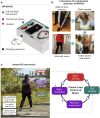Amplifying walking activity in Parkinson's disease through autonomous music-based rhythmic auditory stimulation: randomized controlled trial
- PMID: 40301366
- PMCID: PMC12041193
- DOI: 10.1038/s41531-025-00952-x
Amplifying walking activity in Parkinson's disease through autonomous music-based rhythmic auditory stimulation: randomized controlled trial
Abstract
Habitual moderate intensity walking has disease-modifying benefits in Parkinson's disease (PD). However, the lack of sustainable gait interventions that collectively promote sufficient intensity, daily amount, and quality of walking marks a critical gap in PD rehabilitation. In this randomized controlled trial (clinicaltrials.gov#: NCT05421624, registered on June 6, 2022), we demonstrate the effectiveness of a real-world walking intervention delivered using an autonomous music-based digital rhythmic auditory stimulation (RAS) system. In comparison to an active-control arm (N = 20) of moderately intense brisk walking, the autonomous RAS system used in the experimental arm (N = 21) amplified moderate-to-vigorous walking intensities, increased daily steps, and improved (reduced) gait variability. While regular engagement in real-world walking with or without RAS each cultivated habits for walking, only the RAS intervention yielded a combination of strengthened habits and improved gait outcomes. Findings from this study supported the use of a personalized, autonomous RAS gait intervention that is effective, habit-forming and translatable to real-world walking in individuals with PD.
© 2025. The Author(s).
Conflict of interest statement
Competing interests: L.N.A. is a paid advisor to MedRhythms Inc. The remaining authors declare no competing interests.
Figures








References
-
- Kwakkel, G., Goede, C. J. T., De & Wegen, E. E. H. Van. Impact of physical therapy for Parkinson ’ s disease: A critical review of the literature. Parkinsonism Relat. Disord.13, S478–S487 (2007). - PubMed
-
- Oguh, O., Eisenstein, A., Kwasny, M. & Simuni, T. Back to the basics: Regular exercise matters in Parkinson’s disease: Results from the National Parkinson Foundation QII registry study. Parkinsonism Relat. Disord.20, 1221–1225 (2014). - PubMed
Associated data
Grants and funding
LinkOut - more resources
Full Text Sources
Medical
Miscellaneous

